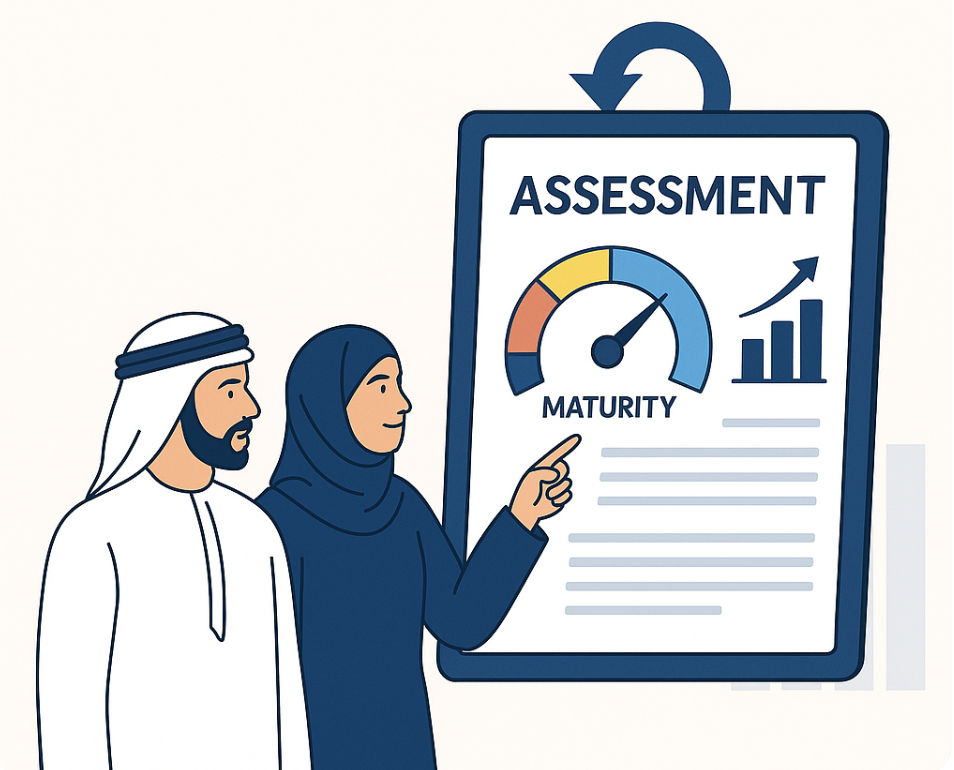Agile transformations are not just about changing the way your teams work. They represent a fundamental shift in mindset, culture and approach to delivering value to customers. Often, we see businesses that are embarking on their Agile journey seeking shortcuts by skirting around elements of Agile frameworks, such as Scrum. Even worse, the organisation’s management orders the teams to “Go Agile” without a fundamental appreciation of their impact on any transformation progress (we also talk about this in our “The Scrum holy grail: how to deliver more, faster, and with less people” post here).
In taking these shortcuts and/or not appreciating their critical role in the transformation process, they undermine the very essence of Agile, which will inevitably lead to suboptimal results. Suboptimal results typically leads to Agile being blamed for the failure, which in turn leads to organisations falling back to old ways of working, which have presumably already been identified as being suboptimal given the initial desire to “Go Agile”... So ‘suboptimal’ becomes a persistent, accepted norm.
In this article, we will discuss what we believe are the three non-negotiable foundations to really driving Agile change in organisations. So if you’re in a management role and are considering an Agile transformation, or you’ve been assigned responsibility to deliver one, read on…
Get in touch with us for a free consultation if you would like to explore any of the topics discussed below, or to find out how our enterprise Agile coaches could help your business to deliver faster, better and cheaper.
1. Embracing cultural change
In our opinion, the most important, non-negotiable is to understand the need for true cultural change within the entire organisation. And that’s from the top down.
Put simply, an Agile transformation will not work in a silo. You could have multiple teams all highly adept in Agile practices, who are deeply motivated to self-organise, who embody the Agile values and focus on customer value first, but if they are constantly dealing with external forces that work against their ability to use the Scrum Framework, they will likely eventually give up.
A transformation journey in this situation will probably start well - there’ll likely be a degree of increased transparency, potentially an uptick in team morale and one or two wins that suggest that the empirical process that Agile brings is working. However, you’ll only get so far in the journey, as shown in the chart below.
After a positive start, teams will eventually reach a plateau whereby they are unable to escape a mechanistic approach to Agile - one whereby they are going through the motions but not really seeing or feeling the full benefits of Agile. This is a dangerous point whereby the journey could come to an equally rapid, morale-sapping end. It is a clear sign that the organisation’s culture is not set up to support the transformation and real effort should be put towards identifying and removing those cultural impediments.

Examples of such impediments that we’ve unfortunately seen on a fairly regular basis - particularly in large organisations - include:
- A management layer wanting to retain centralised, micromanagement control and not trusting teams with a problem to solve
- Agile teams being dependent on other parts of the organisation that do not understand or do not follow Agile practices
- A perception from leaders that Agile means more scope, less time, less cost, leading to inevitable disappointment - and blame throwing - when this doesn’t materialise
- Stakeholders not aligning to Agile practices, such as the Scrum Events, and wanting to be given special attention by the team (e.g. having their own update meetings outside of Sprint Review, or being able to demand that a team’s work priorities shift at any moment)
The above behaviours work against the spirit of Agile and when teams see them being exhibited, it’s natural for them to start questioning whether the Agile Transformation is really a goal of the organisation, or whether it’s just the latest management buzzword doomed to be dropped within the next 6 months.
Management has a crucial role to play in Agile but it requires them to let go of legacy ways of working and to be courageous (a Scrum value). Change from a typical management mindset to that of a leader (even better: a Servant Leader) and Agile will allow your teams to flourish.
2. Understanding what success looks like
When embarking on an Agile Transformation programme, clarity is paramount. While team enthusiasm and drive can catalyse change, a lack of clear direction can lead to chaotic and disjointed efforts, yielding suboptimal results (such as those outlined above). Defining what success looks like is step one, and this is best encapsulated in carefully crafted goals. Yet, the mere act of setting goals is not enough. They must be measurable, tangible, and most importantly, in line with the overarching corporate strategy.
The corporate strategy acts as the North Star for the entire organisation. In theory, every in-flight project or initiative should help move the organisation closer to its North Star - if it doesn’t, why are we working on it?
But how does this cascading effect trickle down? After all, Agile Transformation is as much about individual, self-managing Agile teams as it is about the broader organisation. This is where the alignment of transformation KPIs with team-level Product Goals becomes invaluable. Each Agile team, while having the autonomy to manoeuvre, should be clear on how their efforts directly contribute to the overall transformation goals. It ensures not only alignment but also coherence in purpose and action.
Moreover, this symbiotic relationship between organisational KPIs and team-level goals ensures a holistic approach to agility. Teams aren't merely working in silos, chasing disparate objectives. Instead, they operate with a unified purpose, marching towards an overarching vision, which in turn is aligned meticulously with the corporate strategy.
In conclusion, KPIs are more than just a managerial tool; they are at the core of successful Agile Transformations. They offer a snapshot of where the organisation currently stands, how far it has come, and how much further it needs to travel. It also gives teams a powerful tool with which they can prioritise Product Backlogs.
Without them, the journey towards agility risks becoming aimless. So, as organisations look to embrace agility, they must remember to align, measure, and pivot, ensuring every step taken resonates with their ultimate goal.
3. Empowered Product Owner
The Scrum Framework, as described in the Scrum Guide 2020, is built upon Accountabilities (formerly roles), Events, and Artifacts, each designed to offer clarity and improve efficiency. Central to this framework is the Accountability of the Product Owner. Described as accountable for "maximising the value of the product resulting from the work of the Scrum Team" the Product Owner’s role is both vital and demanding.
For a Product Owner to truly shine, empowerment from the wider organisation isn’t just nice-to-have; it's an absolute must-have.
One of the foundational tenets set out by the Scrum Guide is that there should be only one Product Owner for a single Product Backlog. This guideline is set for a reason. When multiple voices attempt to dictate a product’s direction, conflicting visions can lead to dilution of the product’s value, creating ambiguities for the Developers (the people in the team doing the work to create the actual product). In contrast, a singular, empowered Product Owner ensures that the product vision remains consistent and clear, allowing the Scrum Team to operate with purpose and direction.
However, the reality is that in many organisations, the Product Owner often operates with one hand tied behind their back, stymied by layers of bureaucracy, conflicting interests, and a lack of true empowerment. When the broader organisation doesn’t fully trust or empower the Product Owner, several detrimental outcomes can emerge:
- Reduced efficiency: A Product Owner constantly seeking approvals for every decision will result in delays, reducing the team's ability to respond rapidly to market changes or customer feedback.
- Diluted product value: Without a clear, autonomous voice guiding the product, its value can be watered down by competing priorities and a lack of clear focus.
- Demotivation: A Product Owner, despite being best placed to understand the product’s stakeholders and end-users, if undermined, can lead to demotivation and diminished morale.
- Blurred accountabilities: Scrum thrives on clear roles and accountabilities. If a Product Owner is not empowered, nobody knows who is the voice of authority when it comes to product decision making. Teams will likely fill this void by taking direction from anyone they can find, resulting in potential misalignments and wasted time.
True empowerment means that the wider organisation respects the Product Owner's decisions, understanding and trusting that they are made in the best interest of the product's users and stakeholders. This empowerment also includes giving the Product Owner the necessary training, tools, and trust to do their job effectively.
In essence, a truly empowered Product Owner isn’t just a title or role but an embodiment of the product’s vision and its path to value. Organisations that understand this and respect the guidelines of Scrum don't just get a product; they get a product that resonates, delivers value, and stands out in the marketplace.
Concluding Thoughts
An Agile Transformation is a big undertaking - it’s not easy. It’s also not necessarily a quick process: we advise our larger clients and partners to expect true transformation to become embedded over a 12-18 month period. That’s not to say benefits won’t be seen sooner - the initial learning curve is usually rapid and teams can be up-and-running with the Scrum Events pretty quickly. But we always encourage patience.
To achieve the largest benefits that Agile will bring and to create an environment where there is a minimal risk of reverting back to the comfortable (yet inefficient) muscle memory of legacy ways of working, that requires organisations to apply the foundations that we’ve recommended above and to create an environment where the organisation is setup - practically and culturally - to allow teams to really embrace Agile.
Do this and the rewards will far outweigh the 12-18 month time investment.
Eager to begin your Agile transformation journey? Contact Agility Arabia for a free 30-minute initial consultation to discuss your needs and challenges.




